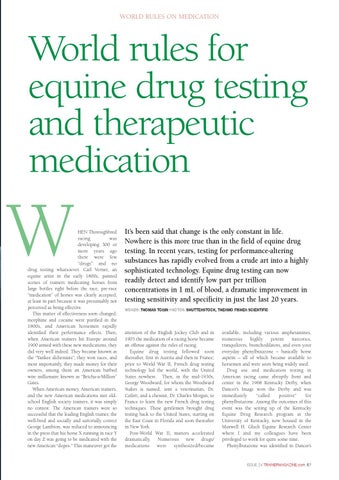WORLD RULES ISSUE 24_Jerkins feature.qxd 15/04/2012 22:31 Page 2
WORLD RULES ON MEDICATION
World rules for equine drug testing and therapeutic medication
W
HEN Thoroughbred racing was developing 300 or more years ago there were few “drugs” and no drug testing whatsoever. Carl Vernet, an equine artist in the early 1800s, painted scenes of trainers medicating horses from large bottles right before the race; pre-race “medication” of horses was clearly accepted, at least in part because it was presumably not perceived as being effective. This matter of effectiveness soon changed: morphine and cocaine were purified in the 1800s, and American horsemen rapidly identified their performance effects. Then, when American trainers hit Europe around 1900 armed with these new medications, they did very well indeed. They became known as the “Yankee alchemists”; they won races, and most importantly, they made money for their owners, among them an American barbed wire millionaire known as “Betcha-a-Million” Gates. When American money, American trainers, and the new American medications met oldschool English society trainers, it was simply no contest. The American trainers were so successful that the leading English trainer, the well-bred and socially and sartorially correct George Lambton, was reduced to announcing in the press that his horse X running in race Y on day Z was going to be medicated with the new American “dopes.” This maneuver got the
It’s been said that change is the only constant in life. Nowhere is this more true than in the field of equine drug testing. In recent years, testing for performance-altering substances has rapidly evolved from a crude art into a highly sophisticated technology. Equine drug testing can now readily detect and identify low part per trillion concentrations in 1 mL of blood, a dramatic improvement in testing sensitivity and specificity in just the last 20 years. WORDS: THOMAS TOBIN PHOTOS: SHUTTERSTOCK, THERMO FISHER SCIENTIFIC
attention of the English Jockey Club and in 1903 the medication of a racing horse became an offense against the rules of racing. Equine drug testing followed soon thereafter, first in Austria and then in France; prior to World War II, French drug testing technology led the world, with the United States nowhere. Then, in the mid-1930s, George Woodward, for whom the Woodward Stakes is named, sent a veterinarian, Dr. Catlett, and a chemist, Dr. Charles Morgan, to France to learn the new French drug testing techniques. These gentlemen brought drug testing back to the United States, starting on the East Coast in Florida and soon thereafter in New York. Post-World War II, matters accelerated dramatically. Numerous new drugs/ medications were synthesized/became
available, including various amphetamines, numerous highly potent narcotics, tranquilizers, bronchodilators, and even your everyday phenylbutazone – basically horse aspirin – all of which became available to horsemen and were soon being widely used. Drug use and medication testing in American racing came abruptly front and center in the 1968 Kentucky Derby, when Dancer’s Image won the Derby and was immediately “called positive” for phenylbutazone. Among the outcomes of this event was the setting up of the Kentucky Equine Drug Research program at the University of Kentucky, now housed in the Maxwell H. Gluck Equine Research Center where I and my colleagues have been privileged to work for quite some time. Phenylbutazone was identified in Dancer’s
ISSUE 24 TRAINERMAGAZINE.com 67
